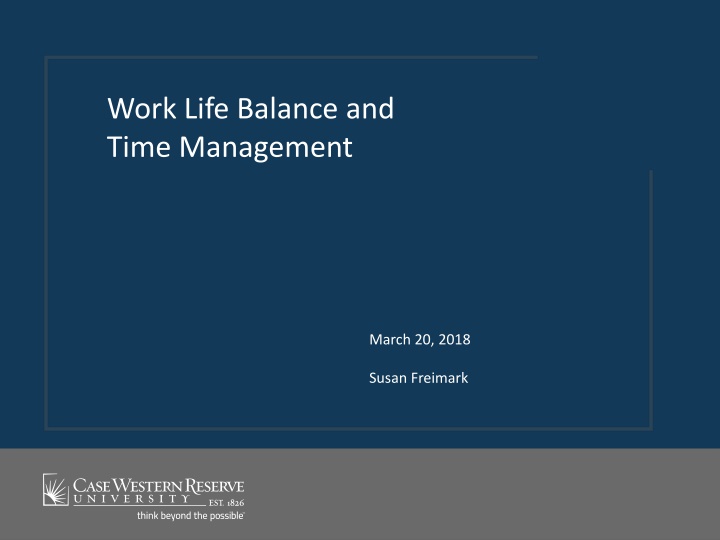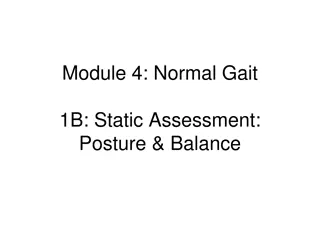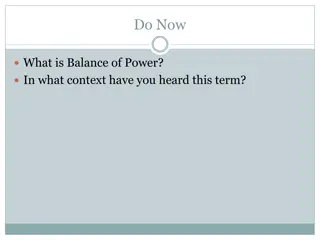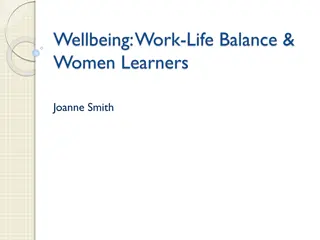
Efficient Strategies for Work-Life Balance and Time Management
Discover effective methods for achieving work-life balance and mastering time management amidst competing demands, distractions, and internal challenges. Learn how to set specific goals, delegate responsibilities, combat procrastination, and enhance meeting productivity. Take control of your schedule and optimize your efficiency to achieve a harmonious work-life equilibrium.
Download Presentation

Please find below an Image/Link to download the presentation.
The content on the website is provided AS IS for your information and personal use only. It may not be sold, licensed, or shared on other websites without obtaining consent from the author. If you encounter any issues during the download, it is possible that the publisher has removed the file from their server.
You are allowed to download the files provided on this website for personal or commercial use, subject to the condition that they are used lawfully. All files are the property of their respective owners.
The content on the website is provided AS IS for your information and personal use only. It may not be sold, licensed, or shared on other websites without obtaining consent from the author.
E N D
Presentation Transcript
Work Life Balance and Time Management March 20, 2018 Susan Freimark
Time Management Challenged by competing demands, multiple overlapping commitments, interruptions, and internal and external distractions Urgent items are the norm Great time management means being effective as well as efficient
Work Life Balance From 1986 to 1996, Work-Life Balance was mentioned in the media 32 times. In 2007 alone, it was mentioned 1,674 times. Social Media keeping us constantly plugged in. Work life satisfaction, not work life balance. High achieving individuals take on work life balance as a challenge. The key to work life balance is a feeling of control.
Lets Get Started Create a to do list from a typical day or week, including everything you feel you have to do, however unimportant
What Slows Us Down? Not having specific goals Lack of delegation of responsibilities Procrastination Managing meetings Setting boundaries Difficulty saying no
Facing the Challenges Setting specific goals SMART (Specific, Measurable, Achievable, Results Oriented, Timely) Delegation of responsibilities Provides an opportunity for others to develop additional skills Delegating is part of being a leader Clarify the desired result Jointly decide on a timeline Clarify the range of decision making
Facing the Challenges Procrastination 20% of the population are procrastinators Actively look for distractions The task is distasteful Stop thinking and take the first step Do the hardest task first Examine your own fear of success
Facing the Challenges Managing meetings Have an agenda (with time blocks) and stick to it Determine the reason for the meeting Rein people in if they go off topic or talk too long, or monopolize the conversation Summarize the main points and action steps
Facing the Challenges Setting boundaries Be decisive about what you need and want There should be no guilt in establishing reasonable boundaries Know what is important to you Start small Have a plan or strategy Difficulty saying no
Two Types of Activities Important Activities Leads to achievement of your personal or professional goals Urgent Activities Demand immediate attention and are often associated with the achievement of other people s goals The Eisenhower Matrix What is important is seldom urgent and what is urgent is seldom important The Urgent/Important Matrix Developed in 1994 by Steven Covey
Coveys Time Management Grid URGENT NOT URGENT Quadrant I: Urgent and Important Quadrant II: Not Urgent but Important IMPORTANT Quadrant IV: Not Urgent and Not Important NOT IMPORTANT Quadrant III: Urgent and Not Important
The Urgent/Important Matrix Quadrant I: Urgent, And Important Ones you could not foresee Ones you left to the last minute Avoid by planning ahead and not procrastinating Do it immediately Quadrant II: Not Urgent, But Important Activities that help you achieve your goals Make sure you plan enough time for unforeseen problems Decide when you will do it Quadrant III: Urgent, But Not Important Not really important but someone else wants it Things that stop you from achieving your goals Delegate to someone else Quadrant IV: Not Urgent, Not Important Activities that yield little value Do it later
Saying No In what types of situations are you more likely to say no? In what types of situations do you find it more difficult to say no? What is the risk in saying no? What is the risk in not saying no?
What Stops Us From Saying No? You re concerned about being rude Yes is your automatic response You want to be a good community member You want to avoid a conflict You re afraid of what you might miss out on if you say no You re concerned about building bridges, not burning them
Ways to Say No Saying no is about respecting and valuing your time and space. I can t commit to this because of my current priorities. Let s plan on reconnecting at X time. Let me think about this and get back to you. Janice would be better for this than I. This doesn t fit in with what I m working on right now. I m honored to be asked, but I need to pass on this opportunity right now. If your dean asks you to serve on a committee, ask from which other committee he/she thinks you should resign. If you must say yes, try to reduce the scope of demands. Just say no.






















